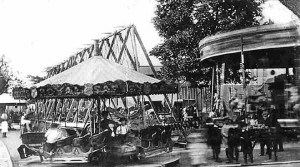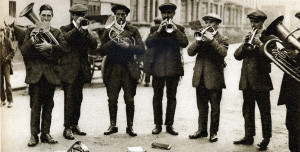Mary Hollinrake (b. 1912): Habits, Culture & Belief (part 2)
In part one, I discussed Mary’s involvement with the community and also how she spent some of her teenage years. For my second post on Habits, Culture and Beliefs, I will feature Mary’s time spent with her family. As a child, Mary’s life was very family orientated and her days were in a routine that she stuck to for many years. “Monday was washday” (19), “baking day was Thursday” (22) and since she had tea at her Grandmother’s most nights, “Friday was teatime at home too as I have never had a fancy for liver” (22).
Mary had a large family who spent a lot of time together; “My mother’s family was close knit” (35). As for most families, Sundays were a significant day in spending time with family as it was a work and school free day. For Mary, “Sundays were a round of visits to my mother’s sisters or brother except when they were coming to us, I don’t think we missed a single week” (37). It would have been an important day for them as the “Best china and cutlery was brought out” (38) for lunch and afterwards, they put on their Sunday best. Memories of these years are portrayed positively, with Mary writing “I liked going to all these aunts. I was always free to go anytime, unannounced, by myself or with friends and was always received with open arms” (39).
They also made frequent trips her Uncle Robert’s farm in Clinton, which she enjoyed visiting the most. “The long walk was much enjoyed” (39) and once they had arrived, their “welcome was always the same, warm was too light a word for it” (40). Mary was very fond of it there, and “spent many hours (or wasted them) day dreaming on my cousin’s swing” (41). Whilst there, she helped collect the freshly laid eggs and watched her aunt Edith churn butter, which she clearly remembered well as it was described in a lengthy process. Mary wrote “Many times there were a dozen or so of us there on Sunday and occasionally there would be my mother’s cousin from Bacup and a cousin or two of my aunt Edith’s” (46). In her memoir, this section is written over six pages in total with some parts in great detail, showing how much she remembered and enjoyed her time there.

The fair arrived in Todmorden in September which had “round-ab-bouts and swings and dodgems, coconut shies and all the fun of the fair” (50). Although, what came with it put Mary off as she “didn’t like a lot of this noisy entertainment when young” (50). Instead, she “loved” (50) the pot fair which was held usually around the same time and she would attend at night with her mother and aunts. People bought crockery there, but Mary wrote that “everybody went as much for the entertainment” (50), once again showing the rise in mass entertainment for the working class. The men who ran the stalls “were like jugglers” and she wrote that one “was calling out the prices, cracking jokes and engaging in witty chatter” (51). She then said “I enjoyed the pot fair as much as the adults, it was as good as a variety show and you often got a good bargain” (51), confirming the rise in commercialization in the twentieth century and the increase in the working-class becoming consumers.

Mary noted the groups and societies that were held in Todmorden; “There were local amateur operatic and dramatic societies, they were popular and there was a lot of talent” (30). There was also “splendid local brass band” (30) and “a local string orchestra too” (31) which would have been significant in working-class communities as Andy Croll stated “Drinking in pubs, playing in brass bands, singing in choral societies, betting ‘on the dogs’, pigeon fancying, all were instances of popular cultural practices that could be understood as being inscribed with class meanings” (402).
From these two posts on Mary’s habits and culture, we can see that she benefited from the mass entertainment and cultural events that were provided for the working-class, and therefore the reasons behind the majority of the positive childhood memories in her memoir alongside the routine family visits.
References
Croll, Andy. ‘Popular Leisure and Sport’ in Chris Williams (ed) A Companion to Nineteenth-Century Britain. Oxford: Blackwell, 1984, pp. 396-411.
Hollinrake, Mary. ‘Lancashire Lass’. Burnett Archive of Working Class Autobiography, University of Brunel Library, Special Collection, 2:413. Extract in John Burnett, David Vincent and David Mayall (eds) The Autobiography of the Working Class: An Annotated, Critical Bibliography 1790-1945, 3 vols. (Brighton: Harvester, 1984, 1987, 1989): 2:413.
Image of a 19th C funfair.
http://www.irvinleisure.co.uk/about/irvin-history/
Image of a brass band in 1920’s London.
https://www.flickr.com/photos/ warsaw1948/7993521216

Leave a Reply